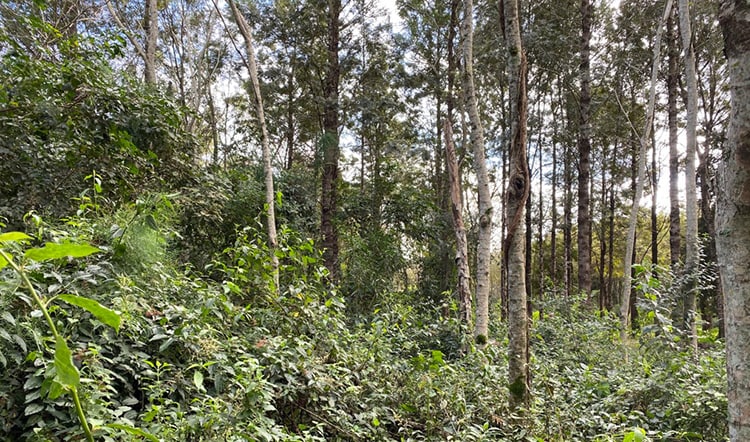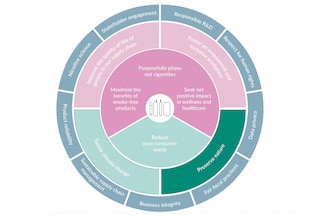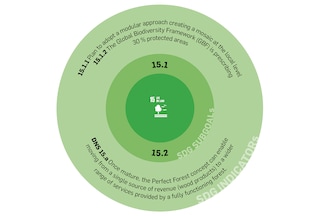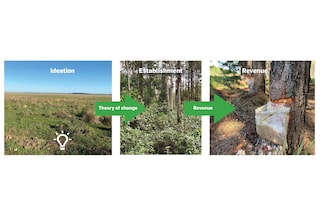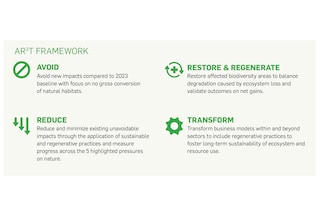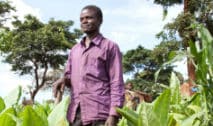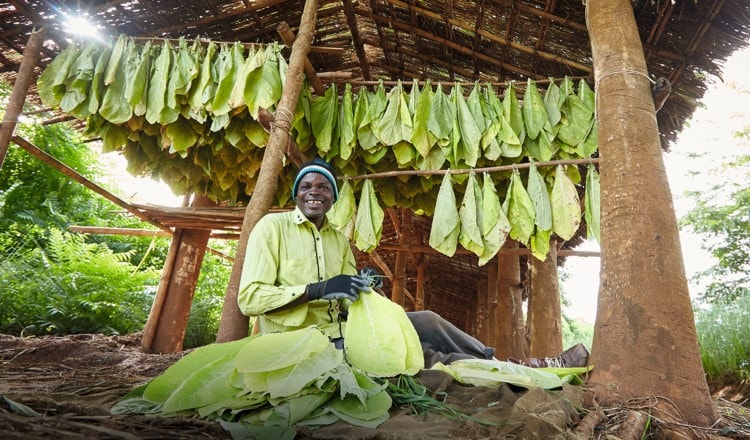Perfect Forest™ is PMI’s nature-based solutions (NbS) concept to preserve forest resources. We believe that constant effort at the landscape level is key for transforming our relationship with forest ecosystems and local stakeholders. For us, “perfection” is the mutual contribution between the protection of nature and its resulting ecosystem services.
Anchoring sustainability at the core of our strategy
At PMI, sustainability is more than just a means to minimize negative externalities and mitigate risks while maximizing operational efficiency and resource optimization. We see it as a fundamental opportunity for innovation, growth, and purpose-led, impact-driven, long-term value creation. Accordingly, we work hard to integrate sustainability into every aspect of our business and activities. The health impact of cigarette smoking is the most significant and pressing negative externality our strategy aims to address. Lessening this impact is the most valuable societal contribution we can make and is the cornerstone of PMI’s purpose and business strategy.
Our approach to sustainability must also address other material ESG topics related to our products and business operations. Preserving nature is a critical component of this strategy. PMI’s Perfect Forest™ concept offers a unique and innovative solution contributing to SDG 15 as it aims to nurture the kind of planned forest growth that perfectly mimics nature.
According to the FAO, despite global progress towards forest management, forest losses remain high. SDG indicator 15.1.1 seeks to ensure that forests are efficiently managed and encourages a better balance between conservation and sustainable use of natural resources.
The Perfect Forest™ concept will aim to sequester carbon while enhancing the forestry systems’ potential to deliver sustainable forest products and societal benefits. It will also aim to create the conditions for protecting water resources, balancing soil elements, and preserving natural habitats, which are key to supporting biodiversity.
Since the rise of industrial forestry, forest management has largely focused on maximizing production yield (e.g., timber in construction, wood for furniture and panels, or biomass for energy). This kind of forest management often reduces the ecosystem services provided by a forest stand. This is a serious problem. Forests are critical for limiting global warming to 1.5°C and for supporting interconnected biodiversity systems across the planet.
Despite an increased focus on planting industrial forests to release pressure on natural ones, deforestation rates are not falling fast enough, and we still see a net loss of forests globally.
At this stage, Perfect Forest is a concept. However, once it reaches maturity, it will aim to provide:We at PMI strive to prioritize environmental stewardship for natural forests. With our Zero Deforestation program, launched in 2018, we have used the program to validate if the tobacco we purchase poses any risk to primary or protected forests linked to tobacco production. Furthermore, to support a forest-positive future and based on our Zero Deforestation Manifesto, we go beyond protecting pristine forests to prescribe and regulate sustainable forest management in natural forests across PMI’s supply chain. We have expanded the program beyond tobacco to paper- and pulp-based materials with a target to achieve zero gross deforestation by 2025 and zero net deforestation in managed forests by 2030.
At PMI, we believe that avoiding deforestation should go hand in hand with renewed approaches for forest management to value a forest beyond the revenue generated by its wood products. For PMI, the entire forest ecosystem is valuable. That is why we are striving to usher in a new paradigm for forest management through the Perfect Forest™ concept.
Through our Perfect Forest™ concept, we build on our deep experience in agricultural supply chains to apply principles of NbS to carbon sequestration, working with global forestry experts and engaging local communities as we develop innovative methods for harnessing the positive benefits that forest ecosystems provide.
The Perfect Forest™ will aim to generate revenue by providing wood products, forest products, and bioenergy. Through careful, close-to-nature silvicultural management—a practice that focuses on managing a forest for ecosystem services—the forest can also provide a host of benefits, including pollination, shading, air purification, insect population control, and more. And finally, it will seek to deliver societal benefits for communities surrounding the forest.
How it works
The overarching goal of the Perfect Forest™ Concept is to create long-term carbon storage, resulting in a carbon sink for CO2 absorbed by growing trees, soil, roots, etc. In the concept, PMI is directly involved in creating and managing the Perfect Forest™, either by holding the stewardship of the land directly or by applying influence indirectly through value chain partners.
The Perfect Forest™ model is based on an ecological approach that can be implemented starting from a degraded natural forest or from bare land, depending on whether the intervention is a reforestation or afforestation. The biology of the land, ecology, trees, and local environment need to be understood in order to create the necessary conditions for the entire ecosystem to thrive. The layout and planting of the Perfect Forest™ is also critical. For example, fast-growing softwood species can only be used where there are appropriate soil conditions and water availability. In addition, the seedlings themselves must be planted with a specific design to allow for native species (generally hardwood) to be planted in between. In this way, the planting layout follows a clear distribution inspired by nature.
It is also important to respect the limiting factors of the local area. Limiting factors are the variables that can affect the health and productivity of an ecosystem. For instance, if soil fertility is the limiting factor for the planting region, we would then work to select the appropriate species and plan for the appropriate canopy density accordingly.
Timing is also key: Fast-growing species should be planted in the first rotation cycle to provide shelter and shade to the native trees that grow more slowly. The stand is first thinned after 5 to 10 years and first logged after 12 to 15 years. Thus, the revenue provided by the first harvest supports the investment, management, and growth of the trees that will permanently define the Perfect Forest™ and ensure its longevity.
At the core of the forest, we plan to preserve a large diameter of living trees, leaving dead trees in strategic places to create shelter and microhabitats for insects, birds, small mammals, and fungi—which themselves help sustain the proper functioning of the forest.
When extractions are performed outside of this preserved diameter, any excess material should be fed back into the ecosystem for sustained health and longevity. For example, residue from logging within the early rotation cycles would be collected and heated in the absence of oxygen to create carbon-rich charcoal (biochar) that, when reapplied into the soil, improves the physical and chemical properties of the soil itself, acting as a long-term carbon sink.
Any excess biomass that is not suitable for biochar production can be repurposed as bioenergy. The added benefit of this step will aim to support local communities by providing access to energy, while simultaneously contributing to reduced dependency on fossil fuels, thus helping to further decrease CO2 emissions. It’s an ambitious vision, but because of our experience working with forestry experts and local stakeholders, as well as our experience in agricultural supply chains, we believe the Perfect Forest concept will be beneficial from a financial, social, and environmental perspective.
Measuring progress
PMI plans to apply an impact valuation model to quantify the value of the forest services provided beyond wood production in the Perfect Forest™. Impact valuation enables us to understand the full spectrum of benefits associated with a particular investment over and above simple financial terms. With our approach, we look at natural, human, and social capital value creation, and we include the outcomes of the analysis in the design elements that are considered in the Perfect Forest™ project.
In our decarbonization strategy, we established monetization mechanisms to assign an internal price to the carbon we reduce and remove across our supply chain. This is the first step, and we aim to include additional ecosystem services moving forward as we work to perfect the impact valuation methodology to establish a robust approach for measuring the value generated from the Perfect Forest™.
In the interest of transparency, we plan to certify the Perfect Forest’s generation of carbon credits through one of the internationally recognized voluntary carbon standards, as we have done with other projects through International Carbon Reduction and Offsetting Accreditation (ICROA)). In addition, we aim to employ specific methodologies to demonstrate the benefits for people and biodiversity. We plan to use the Forest Stewardship Council (FSC) Ecosystem Services Procedure to take ownership of the verification and validation of additional ecosystem services related to water, wild species, and resilience to disturbances. And for estimating the volumetric water benefits that will be generated, we aim to deploy PMI’s proprietary Volumetric Water Validation Tool (VWTL), which incorporates a mathematical model to simulate the removal of carbon based on the options available to optimize water benefits.
Our journey to the Perfect Forest™
In PMI’s Perfect Forest™—a multidecade project—the aim is that the societal and environmental benefits generated will grow with the forest and last for the long haul, offering benefits that continue well into the future.
We hope that the Perfect Forest™ will contribute to a mindset shift on investments and their impact—a mindset in line with sustainable growth for the future, for PMI’s stakeholders, the environment, and wider society.
The carbon our Perfect Forest™ will aim to remove, the water it will seek to purify, and the biological diversity it will help to preserve are value drivers over and above more traditional financial indicators. But, nevertheless, we believe will be tangible signs that business and sustainability are mutually reinforcing.
On the journey to the Perfect Forest™, we are working with experts both on forestry and impact valuation, sharing the belief that a different way of growing forests and accounting for a company’s results are possible.
We are building our internal capabilities and knowledge base on sustainable forestry practices—including ecological silviculture. Leveraging the experiences, methodologies, and tools developed across forestry projects within our leaf tobacco supply chain over the past decade also prepares us for success over the long term.
Only by using a multi-stakeholder approach, being humble, sharing our ideas with others, and especially working closely with local communities and key global experts will we see our dream of the Perfect Forest™ become a reality.
Innovating with passion and impact, we hope to continue leading the way, inspiring long-term investment into reforestation and afforestation practices across the private sector.
The article is an excerpt from the 2023 Global Goals Yearbook, Sustainable Impact Matters, published by Macondo Foundation
